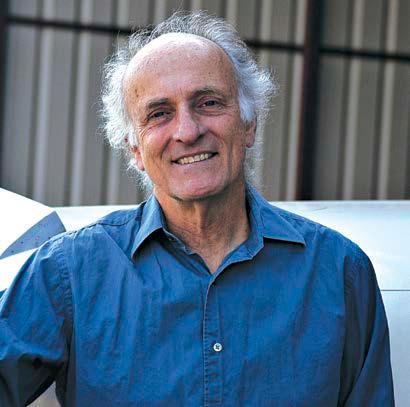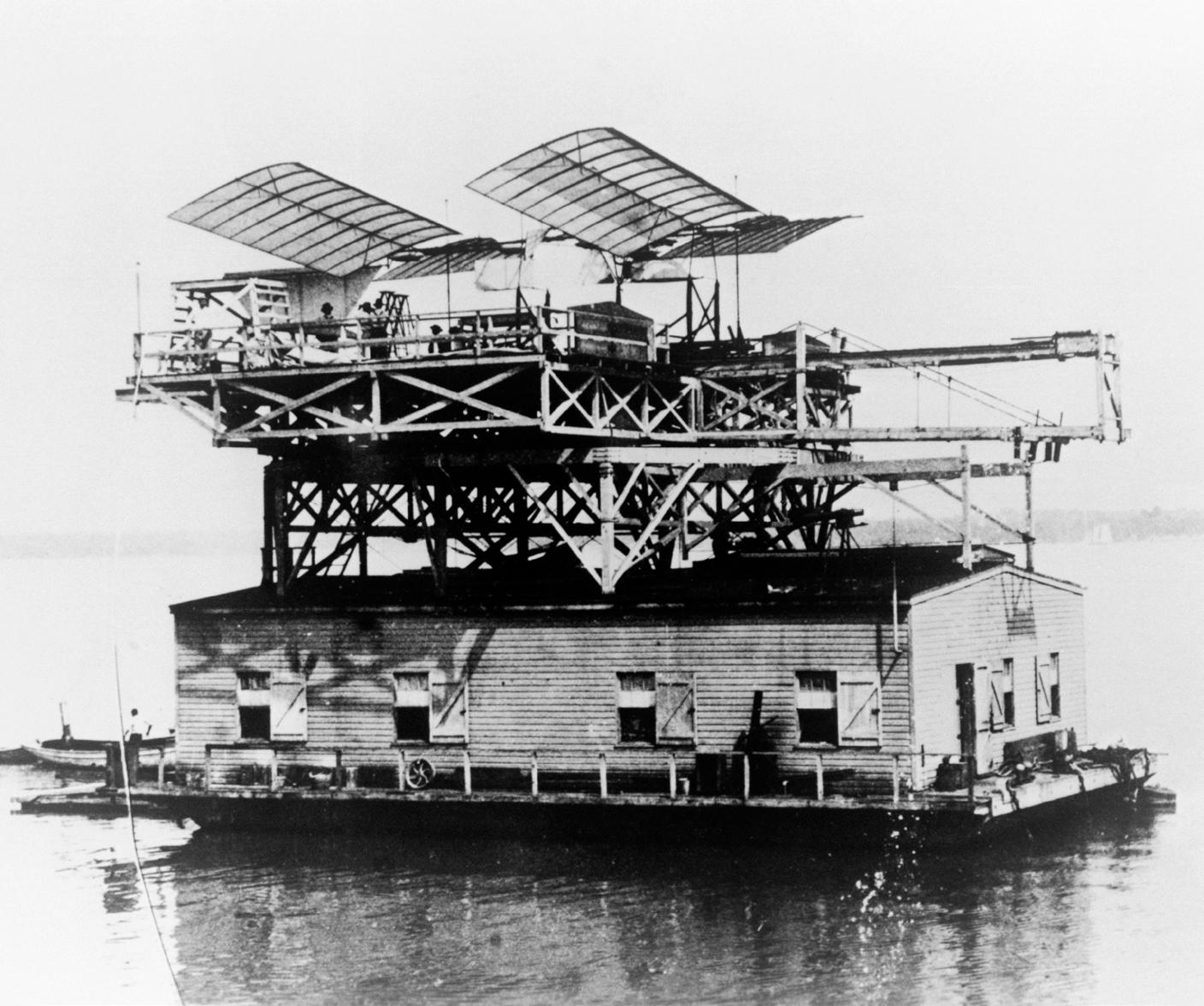
7 minute read
Peter Garrison - NOW, WHITEHEAD
NOW,
WHITEHEAD
History is written by the victors, they say. They also say that the saddest words of tongue or pen are, “It might have been!” And so, in view of the manifest sadness of history, let us pause to pay heed to what was not, and to give some honour to the vanquished.
AMERICANS’ NATIONAL LOVE AFFAIR with In a certain sense, who was first means little. the Wright brothers blinds them to competing So many claimants emerge, all around the claims of priority. From time to time, however, turn of the 20th century, that it’s obvious that another would-be first-flyer clambers into the aeroplane was an invention whose time view. The most recent to do so was Gustave had come. All the necessary components had Whitehead, a Connecticut experimenter who is been put into place by a parade of thinkers and said to have made a powered, controlled flight in experimenters stretching back a hundred years. 1901, two years before the Wrights’ 852-foot hop at Kitty Hawk. PROPULSION Some of these early theorists, largely obscure today, were quite Not that Whitehead, who died in 1927, has AND LIFT remarkable. It’s difficult for us today to empty our returned to speak for himself; instead, the editor SHOULD BE minds of everything we know about flight and to of Jane’s All the World’s Aircraft, Paul Jackson, SEPARATED appreciate the perspicacity of Sir George Cayley, a in the preface to the British peer of extraordinary 2013 edition, awarded intellectual and practical to Whitehead the honour of having made the abilities, who figured out, prior to 1800, most first powered heavier-than-air flight. This claim of what is taught today in ground school about has been made on Whitehead’s behalf before, stability, control, and the four forces acting upon and has always been controversial; what was an aeroplane in flight. noteworthy in 2013 was that it appeared in the prestigious Jane’s. It was like the normally Olympian New England Journal of Medicine’s recent descent to earth to condemn Donald Trump. I am in awe of minds that cut through superficial appearances and received ideas to arrive at the simple essences of things. It was Cayley who realised – a leap that escaped even the
The Langley Aerodrome could have beaten the Wrights
prodigious Leonardo – that a practical aeroplane would be something other than a mechanical bird, and, in particular, that the functions of propulsion and lift should be separated. Cayley is credited with the construction, in 1854, of the first manned glider to fly. Supposedly Cayley’s coachman, whom he dragooned into service as its pilot, was so traumatised by the experience that he gave his employer notice upon alighting – an amusing anecdote for which there is, as far as I know, no evidence.
In 1871 a French experimenter, Alphonse Pénaud, created what we know today as the rubber-band-powered model aeroplane. The configuration of Pénaud’s Planophore – that Gallic neologism, thank heaven, did not find its way into English aeronautical usage – was modern in every respect, including the subtle but important use of what was once called “longitudinal dihedral” and is now called decalage: the setting of the horizontal stabilizer at a slightly negative angle of incidence with respect to the wing. By the end of the 19th century Otto Lilienthal was routinely making flights on a hill outside Berlin in what we would now call weightshift hang gliders. Lilienthal was a scientific thinker whose classic book, Bird Flight as the Basis of Aeronautics, displays a methodical analytical intelligence similar to that of the Wrights. Unlike his predecessors, Lilienthal became world famous; no one interested in the problem of flight at the time was ignorant of his achievements.

At the turn of the 20th century controlled heavier-than-air flight was manifestly possible. The missing element had been a sufficiently light and powerful engine; but now that, too,
was available, and the technology of what would soon become aeroplanes was sufficiently familiar for various experimenters, including the Wrights and Gustave Whitehead, to build their own.
According to a 1901 report in a local newspaper, Whitehead, a Bavarian immigrant born Weisskopf, had built an aeroplane with two engines, one driving the wheels on the ground and the other driving two propellers in flight. In this machine, whose wings could be folded, he one day drove through the predawn streets of Fairfield, Connecticut to a suburban field and there flew half a mile, making some modest turns before landing gently. There are subsequent claims of even longer flights, but no photographic record survives, nor was any attempt apparently made to credibly witness and document the momentous realisation of mankind’s millennia-old dream.
If every past event reported by witnesses were real, the world would be a more magical place than it is. Historians have naturally questioned whether Whitehead’s curiously trouble-free flight really took place. Some of his contemporaries later said that he did fly, others said that he didn’t. Jane’s reopened the question by voting in Whitehead’s favour. The evidence is hardly conclusive, and modern recreations of Whitehead’s machine have not duplicated his alleged flights. Whitehead’s wing resembled Lilienthal’s and Cayley’s: semi-circular in planform, clothcovered, it relied on slender bamboo battens, braced by wires, to maintain a cambered shape. Beneath the wing was a boat-like fuselage, very similar to that of Cayley’s glider. Although early experimenters appreciated the importance of light weight and knew how to achieve it, with two engines and a pilot aboard, Whitehead’s machine must still have been fairly heavy. I don’t know how powerful his homemade engines may have been, nor how, or whether, he measured their output. Nor do I understand how he connected his flight engine to the two propellers, whose speed he claimed to be able to vary independently to steer the craft. On balance, I find the description of the 1901 flight unpersuasive; it all unfolds too smoothly, too perfectly. Of course, this untroubled surface may be the fault of the reporter, not Whitehead himself.
But a series of subsequent misfortunes seems contrived to explain away the lack of indisputable evidence. Photographs of Whitehead’s craft in flight were supposedly “spoiled” because the weather was cloudy and rainy; but would an aeroplane with cloth wings have been taken out to fly in rainy weather? And if it flew so effortlessly once, would it not fly another time when conditions were more suitable for photography? Later, a powerful V-8 engine built by Whitehead was being tested in a boat, for some reason, and ended up at the bottom of Long Island Sound. The Fates seem to have conspired to annihilate the evidence of Whitehead’s genius. A certain amount of local boosterism sustains rival claims of being, in the words of North Carolina license plates, “first in flight.” Those of Whitehead tend to be supported by Connecticutters and by the burghers of Leutershausen. France, en revanche, backs Clément Ader, an impressive autodidact inventor who supposedly made a short hop in a batlike steam-powered contraption in 1890. In the absence of conclusive evidence – the Wrights’ spectacular and elegant photographs are pretty conclusive – early claims of powered flight must be judged in terms of their technical
THE WRIGHT FLYER WAS UNSTABLE
Gustav Whitehead's claim to be the first is unlikely
plausibility. By that standard, Ader’s Éole (named after Aeolus, the Greek god of winds) does not qualify. A cambered flying wing without trailing-edge reflex or a stabilising tail surface just won’t work. But when science does not serve one’s argument, semantics may. Partisans of Ader downplay questions of controllability and stability – the Wright Flyer was unstable too – and emphasise the claim that Ader’s craft got airborne under its own power, whereas the Flyer had to be launched from a rail by an external catapult. Verbal quibbles have always bedevilled efforts to define “powered flight”. It seems that a flight must be both “sustained” and “controllable” to qualify, but even those words admit of broad interpretation. Unless flight is sustained for quite a long time, it is impossible to know how controllable it is. As for getting airborne with external aid or taking off under one’s own power – that is a distinction that seems to have been created expressly to take the palm from the Wrights and award it to either Ader or SantosDumont, the Brazilian-born Parisian dandy whose kitelike 14bis of 1906 actually was, if we discount the Whitehead claims, the first aeroplane to take off on wheels under its own power. Although the lively rivalry between the Wrights and Samuel Langley, then head of the Smithsonian Institution, ended in August 1903, when Langley’s big tandem-wing ‘Aerodrome’ suffered a structural failure and fell ignominiously into the Potomac, it is probable that but for that misfortune Langley’s machine would have flown first. A smaller – but still pretty big – unmanned version had made long flights, and the Aerodrome had an excellent radial engine with a power-to-weight ratio far ahead of its time. Langley is cast in popular memory as the stuffed-shirt city slicker who got a deserved comeuppance from the country-mouse Wrights, but this is not really fair. But for a single weak link, it might be Langley, not the Wrights, who finds himself challenged today by those pesky Whiteheads and Aders.
Ah, what might have been!






